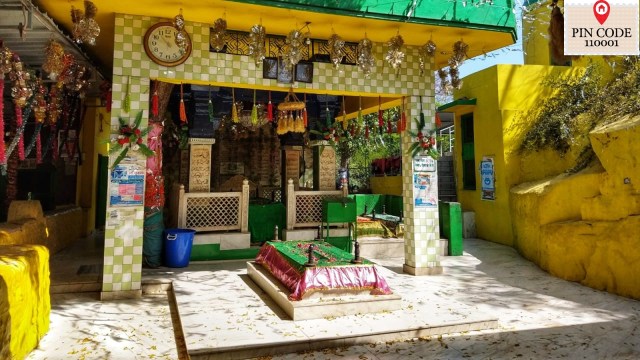Nestled in Sanjay Van, tale of 2‘centuries-old’ Mehrauli shrines
The dargah also houses a famous Sufi landmark where Baba Farid Ganj-Shakkar, one of the founders of the Chisti Sufi order, performed his Chillah-e-Makoos — a challenging spiritual practice in which a person hangs upside down using a rope, often in a well, as per historian Rana Safvi.
 Ashiq Allah dargah was built in 1317. (Image source: Rameen Khan/City Tales)
Ashiq Allah dargah was built in 1317. (Image source: Rameen Khan/City Tales)As one walks down deep into the rocky, undulating terrain of Sanjay Van in Mehrauli, a burst of colour catches the eye. Silver streamers flutter overhead while the walls painted in bright green and yellow stand out amid the stark surroundings: This is the Aashiq Allah dargah.
According to Zafar Hasan’s List of Muhammadan and Hindu Monu-ments, the dargah (shrine) was built in 1317 for Shaikh Shihabuddin Ashiq Allah by Sultan Qutubuddin Mubarak Shah Khilji. According to Sadia Dehlvi’s The Sufi Courtyard, the saint was a disciple of Shaikh Badruddin Ghaznavi, who, in turn, was one of the leading disciples of Qutubuddin Bakhtiar Kaki, whose shrine situated nearby is referred to as the Mehrauli dargah.
Narrating the legend of the Sufi saint in her book, Dehlvi states that once, during Urs festivities of his father, Shaikh Shihabuddin was informed that the langar (community feast) would not suffice for the large number of devotees that had gathered. “Shaykh Shihabuddin ordered that the lid of the food cauldron be covered, and to begin feeding people in the name of Allah. The attendant did as he was told and the food sufficed for everyone,” Dehlvi writes. This legend earned the Sufi saint the moniker of “Ashiq Allah”, or one who loves Allah deeply.
According to the National Mission on Monuments and Antiquities database, the dargah is famous for organising langars for pilgrims even today.
“Locally, the dargah is also called ‘nazariya peer’, believed to have the power to remove the ‘evil eye’, and is quite popular with both locals and pilgrims coming from afar,” says Rameen Khan, who organises heritage walks around Delhi.
The dargah also houses a famous Sufi landmark where Baba Farid Ganj-Shakkar, one of the founders of the Chisti Sufi order, performed his Chillah-e-Makoos — a challenging spiritual practice in which a person hangs upside down using a rope, often in a well, as per historian Rana Safvi.
While the Ashiq Allah dargah still survives, despite demolition fears in light of the razing of Akhoondji Masjid in the neighbourhood, another dargah a few metres away was not as fortunate. This was the Haji Rozbih dargah — a bare structure with just a rough perimeter of stones around two graves. In January, it was demolished by the Delhi Development Authority (DDA) for allegedly encroaching on the Southern Ridge area.
In his book, Hasan mentions that Baba Haji Rozbih was revered as one of the oldest saints to have visited Delhi. It is said the Sufi saint took abode in a cave just below the walls of Qila Rai Pithora in the 12th Century. “Many embraced Islam by his advice, and astrologers… told the Raja that the coming of Baba Haji forboded the advent of the Muhammadan rule into Delhi,” Hasan writes.
The second grave on the premises was believed to have been of a woman; both Hasan’s book and Safvi’s Where Stones Speak — Historical Trails in Mehrauli, The First City of Delhi, state the grave belonged to Prithviraj Chauhan’s daughter Bela Sidhi. According to both historians, local legend states that the princess had converted to Islam under the tutelage of Haji Rozbih. However, in another part of the city, locals claim the princess died by Sati after her husband was killed in battle.
With the twin-grave structure now reduced to rubble, all eyes are now on the Aashiq Allah dargah. In February, a PIL was filed in the Delhi High Court seeking orders to the DDA to desist demolishing the Ashiq Allah dargah and the Baba Farid chillagah, and other monuments in Mehrauli and Sanjay Van. The HC pointed out that the forest was considered the “lungs of the city” and all statutory authorities have to put in efforts to ensure “no illegal or unauthorised construction is carried out on this public land”.












